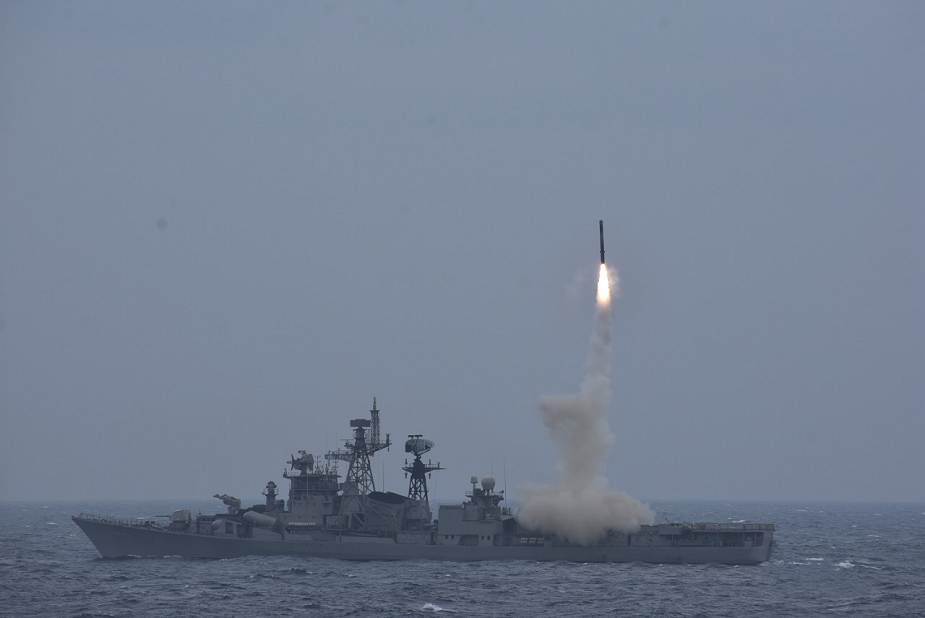Breaking news
Indian Navy successfully test-fires naval version of Brahmos missile from INS Ranvijay Rajput-class destroyer.
According to a tweet published by the Indian Navy Spoke Person on December 1, 2020, the Indian Navy has successfully test-fires a naval version of the Brahmos supersonic cruise missile launched from the INS Ranvijay Rajput-class destroyer, in the Bay of Bengal on Tuesday, December 1, 2020, as part of a series of trials being carried out by the Indian armed forces.
Follow Navy Recognition on Google News at this link
 Indian Navy INS Ranvijay Rajput-class destroyer test-fire naval version of Brahmos supersonic cruise missile. (Picture source Indian Navy)
Indian Navy INS Ranvijay Rajput-class destroyer test-fire naval version of Brahmos supersonic cruise missile. (Picture source Indian Navy)
The INS Ranvijay is a Rajput-class destroyer, currently in service with the Indian Navy. the ship was commissioned on January 1988. The ship is a modified version of the Soviet-made Kashin-class destroyers, also known as Kashin-II class.
The INS Ranvijay is designed to used as anti-aircraft and anti-submarine warfare roles for aircraft carrier task-force defense against submarines, low-flying aircraft, and cruise missiles. She was in of the first ship in the Indian Navy to deploy the BrahMos supersonic cruise missile systems.
The INS Ranvija is armed with 8 Brahmos supersonic anti-ship missiles in aft VLS (Vertical Launching System) and four SS-N-2D Styx AShM anti-ship missiles in inclined launchers. Other armament includes Barak SAM 8 air defense cell launchers, S-125M (NATO: SA-N-1) SAM launcher, 76.2mm naval gun, AK-63M 30mm Close-In Weapon Systems, 533mm torpedo launcher and RBU-6000 anti-submarine mortars.
The BrahMos is a medium-range ramjet supersonic cruise missile that can be launched from submarine, ships, aircraft, or land platforms. It was jointly developed by the Russian Federation's NPO Mashinostroyeniya and India's Defence Research and Development Organisation (DRDO). The land-launched and ship-launched versions are already in service. A hypersonic version of the missile, BrahMos-II, is also presently under development with a speed of Mach 7-8 to boost aerial fast strike capability.
The BrahMos is a two-stage missile with a solid propellant booster engine as its first stage which brings it to supersonic speed and then gets separated. The liquid ramjet or the second stage then takes the missile closer to Mach 3 speed in cruise phase. Stealth technology and guidance system with advanced embedded software provide the missile with special features.
The Brahmos missile has flight range of up to 290-km with supersonic speed all through the flight, leading to shorter flight time, consequently ensuring lower dispersion of targets, quicker engagement time and non-interception by any known weapon system in the world. It operates on the ‘Fire and Forget Principle’, adopting varieties of flights on its way to the target. Its destructive power is enhanced due to large kinetic energy on impact. Its cruising altitude could be up to 15 km and terminal altitude is as low as 10 meters. The missile carries a conventional warhead weighing 200 to 300 kg.
The naval variant of BrahMos missile system was first deployed by the Indian Navy onboard INS Rajput in September 2005. The ship received four BrahMos anti-ship missiles mounted on two twin-missile canisters. The BrahMos missiles provided to the Indian Navy can engage both ships and land targets.



























